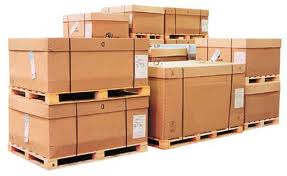How do I pack my cargo? 
Packing The Goods
Packing requirements vary greatly and will depend on the type of cargo being shipped. There are many set rules for successful cargo packing. For example, any movement of the cargo within its own packaging during transit is likely to cause damage. So the tighter and more secure the packing, the less likelihood there will be of damage. We recommend you seek reliable advise on the type of packing requirements for your particular cargo.
We offer a cost-effective, professional cargo packing service.
Please feel free to speak to one of our consultants for an obligation free quote. Our business is your business.
Packing
Packaging of your cargo is one of the most important areas of international trade and also one of the most overlooked resulting in cargo damage ,loss & costly insurance claims
Unit Loads
The type of materials used for shipping will vary according to the product, the type of transportation (ocean or air), and the ultimate destination. However, the basic principle of packaging is known as the "unit load' concept or "unitisation." Unitisation is based upon the theory that all shippers should pack their cargo so it may be moved and handled entirely by mechanical equipment, such as lifts and cranes, throughout the distribution network. This practice reduces the need for labour, the handling of boxes, and the amount of damage. Also, it allows for faster loading and unloading by transportation equipment, more efficient distribution centre operations and a reduced level of pilferage. The reduced costs of the distributor in terms of labour and time often result in cost discounts for the exporter.
In practice, the unit load concept means that small, highly expensive items, such as calculators, should first be totally enclosed in cartons, or double, even triple wall containers to avoid pilferage and damage. Second, the boxes or containers should be secured to pallets with shrink-wrap & plastic strapping. Large items can be secured directly to pallets, assuring that they are adequately protected from damage.
Considerations
- Type of carrier - What are the various types of carriers to be used before the goods arrive at their foreign destination? Usually, truck and ship are used.
- Types of hazard - For each type of carrier, what hazards are the shipments likely to encounter? For ocean shipping, this would include the type of storage, loading and unloading facilities, route, time of year (summer, winter, monsoon, etc.) port reputation, etc.
- Cost factors - As well as ensuring maximum protection for the goods being shipped, the exporter should minimize transportation costs by using lightweight, least bulky materials etc.
Shipping Department Guidelines
- Pack contents tightly within the box, or crate. In this way the container wall is given added strength and harmful shifting of merchandise is avoided.
- Ship large loads whenever possible, as large loads are less likely to be damaged than small ones.
Keep goods protected from rain, seawater and moisture. - Heavy machinery and odd-shaped items should be boxed or crated and provided with skids for easier handling and storage
- Select the most advantageous pallet size and style. A four-way entry pallet permits handling from all four sides with a fork or pallet truck, thus facilitating handling. Additionally, the standard size pallet size of 40 inches by 48 inches (1000mm x1200mm) maximizes the volume, which can be loaded into shipping containers.
- Prepare ferrous surfaces with a rust inhibitor to enable your product to arrive at its destination free from rust or corrosion.
- Drain holes should be made in the skid or floor area of large containers, boxes or crates. This will allow seawater or condensation to flow out of the container.
- Do not try to put too much in each container, as the weight might exceed the limitations of the container being used.
- Ensure weight is distributed evenly within the crate.
- Marks
should be applied with waterproof ink to three surfaces of each
package. Cautionary markings should be in English, the language of the
country of destination and the international graphic-handling symbol.
Protect goods adequately from pilferage. - If the cargo is liquid, do not fill containers completely but leave expansion space to allow for variations in temperature. The cargo should be protected from rainwater damage that may occur when air cargo is taken to loading ramps.
- Shipments by air for liquid cargo, certain additional guidelines apply: The packing should be able to withstand air pressure; liquid cargo should be protected from the hazards of high pressure and leakage.
and against air regulation for shipping liquid or pressurize products without first informing the airline about the contents of the goods and getting permission. As leaking liquid leak may endanger passengers as well as causing the airplane to malfunction - in other words, you can go to jail.
Packing: tips
Consideration to keep in mind when shipping is theft. Theft can be a common problem in some foreign ports. So don’t advertise the contents of your shipping containers with flashy logos or name branding.
p/s :
Should you require specialised container equipment, Freight Rates for Export Shipment (FCL/LCL) or if you
have any further questions please contact us click Here.
